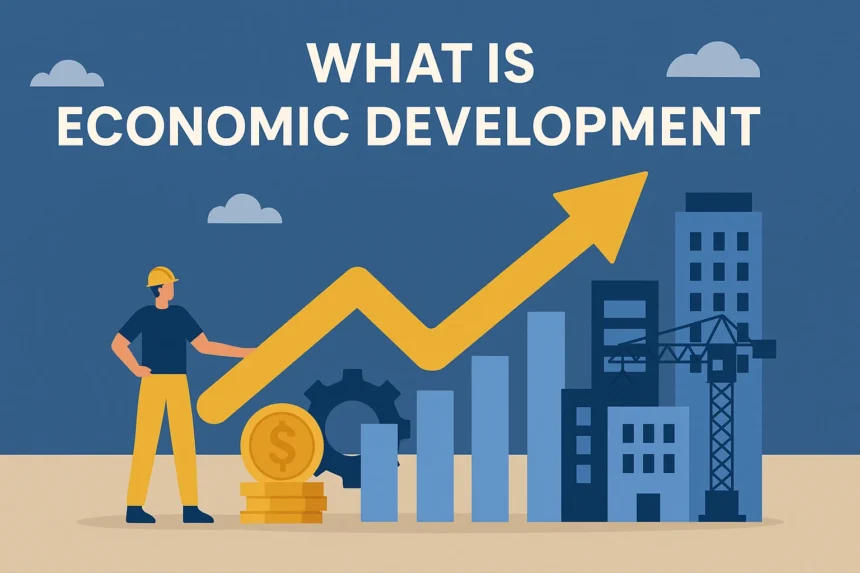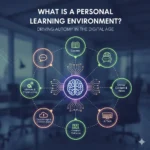A Story of Two Towns
Picture two neighboring towns Riverbend and Oakfield.
Both started small, with farmers trading crops and artisans building homes. Over the years, Riverbend built schools, supported small businesses, and invested in roads and healthcare. Oakfield, however, stayed the same its roads cracked, schools weakened, and jobs grew scarce.
A decade later, Riverbend was bustling with opportunities, while Oakfield struggled to keep its youth from leaving. What made the difference? The answer lies in one powerful concept: economic development.
Defining What Is Economic Development
So, what is economic development?
In simple terms, it’s the process by which a community, region, or nation improves the economic, political, and social well-being of its people. It’s not just about money or GDP growth it’s about creating better living conditions, access to education, stable jobs, and sustainable infrastructure.
Economic development involves long-term actions by governments, private sectors, and communities to promote innovation, investment, and inclusivity. It connects the dots between policy, entrepreneurship, and human progress.
The Core Pillars of Economic Development
Infrastructure and Connectivity
Roads, ports, digital networks, and power grids form the backbone of a thriving economy. Strong infrastructure helps businesses grow, attracts investors, and improves the quality of life for residents. Without it, even the best ideas struggle to reach markets.
Education and Skill Development
A nation’s most valuable resource is its people. By investing in education, training programs, and research, countries prepare their workforce for modern challenges. Skilled citizens fuel innovation, productivity, and adaptability key components of sustainable economic development.
Business and Innovation Growth
Entrepreneurship drives transformation. When governments create an environment where startups can thrive through tax incentives, financial support, and access to markets innovation flourishes. This growth brings new jobs, industries, and opportunities.
Governance and Institutions
Transparent, accountable institutions are essential for progress. Effective governance builds trust, enforces contracts, and ensures fair competition. Corruption and weak institutions, on the other hand, discourage investors and hinder development efforts.
Sustainability and Environment
Economic progress must coexist with environmental responsibility. Green technology, renewable energy, and circular economies ensure that development today doesn’t compromise tomorrow’s resources.
How Economic Development Differs from Economic Growth
Many confuse the two, but they’re not the same. Economic growth measures how much a country’s output its GDP increases over time. Economic development, however, goes deeper. It includes quality of life, equality, education, healthcare, and sustainability.
For instance, if a country’s GDP rises because of oil exports but citizens lack healthcare and education, that’s growth but not development. Real development occurs when economic expansion translates into improved human welfare.
The Role of Governments and Policies
Governments are catalysts of economic development.
Through fiscal policies, investments, and partnerships, they shape the environment where businesses operate. Policies that encourage trade, innovation, and skill-building create ripple effects across all sectors.
Additionally, local governments play a vital role. They connect national plans to community needs supporting small businesses, infrastructure projects, and social programs that directly affect people’s lives.
Private Sector and Global Influence
While governments set the framework, the private sector fuels economic activity. Investments from local entrepreneurs and international corporations alike bring new technologies, capital, and jobs.
Global trade also shapes development. Countries integrated into international markets gain access to new resources, expertise, and opportunities for collaboration. However, globalization must be managed carefully to ensure benefits are distributed fairly.
Human Development and Social Impact
At its core, economic development is about people.
It’s about reducing poverty, promoting equality, improving healthcare, and ensuring everyone has a chance to succeed. The Human Development Index (HDI), created by the United Nations, measures progress using indicators like life expectancy, education, and income.
Nations that prioritize human development tend to achieve more stable and inclusive economic outcomes. A strong economy without human welfare is like a body without a heartbeat it might exist, but it cannot thrive.
Modern Challenges to Economic Development
Climate Change
Rising temperatures, natural disasters, and resource scarcity threaten decades of progress. Sustainable solutions are no longer optional they’re essential for survival and prosperity.
Inequality
The gap between rich and poor nations and even within them continues to widen. Unequal access to education, healthcare, and opportunities hinders inclusive development.
Technological Disruption
Automation and artificial intelligence create both opportunities and challenges. While technology improves productivity, it can also displace traditional jobs if adaptation lags.
Political Instability
Conflict and corruption remain major barriers. Stable governance and transparent institutions are the bedrock of lasting economic progress.
Case Study: South Korea’s Transformation
In the 1960s, South Korea was one of the world’s poorest countries. Through education reform, industrialization, and innovation, it evolved into a global economic powerhouse. Its transformation shows that with the right mix of policies, vision, and investment, nations can achieve rapid and inclusive development.
This story mirrors Riverbend’s journey from the introduction showing how determination, planning, and people-centered growth make lasting change possible.
The Future of Economic Development
The future lies in sustainability, technology, and inclusivity. Green industries, digital transformation, and social innovation will shape how nations progress in the 21st century. Collaboration between governments, businesses, and communities will determine how effectively the world tackles shared challenges.
As artificial intelligence, renewable energy, and global trade redefine economies, nations that invest in education, equality, and adaptability will lead the next wave of development.
Conclusion: Building a Prosperous Tomorrow
In the end, what economic development is more than a definition it’s a vision of progress that uplifts people, not just economies. It’s about building roads, schools, hospitals, and hope. It’s about giving every person the chance to live with dignity and opportunity.
From Riverbend’s story to real-world transformations, the lesson is clear, true development happens when growth meets humanity. And as the world evolves, one principle remains timeless economic development is not just about wealth; it’s about creating a better future for all.




